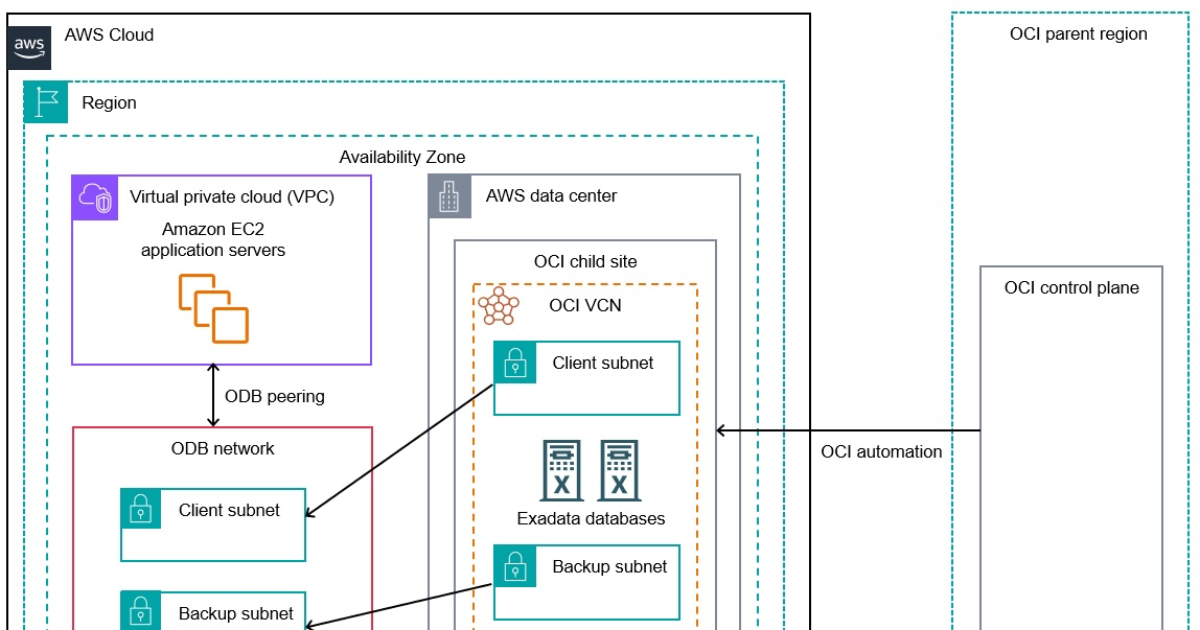AWS recently announced the general availability of Oracle Database@AWS, a new option for Oracle Exadata workloads, including Oracle Real Application Clusters (RAC), within AWS. This new option allows enterprises to migrate Oracle Exadata workloads to dedicated infrastructure on AWS, simplifying cloud migration and unifying data across platforms.
Oracle Database@AWS initially supports two main services: Oracle Exadata Database Service on Dedicated Infrastructure and Oracle Autonomous Database on Dedicated Exadata Infrastructure within AWS data centers. Channy Yun, principal developer advocate at AWS, explains:
These services physically reside within an Availability Zone in an AWS Region and logically reside in an OCI region, enabling seamless integration with AWS services through high-speed, low-latency connections. You create an ODB network, a private, isolated network that hosts Oracle Exadata VM Clusters within an Availability Zone. Then, you use ODB peering accessible to EC2 application servers running in a VPC.
Source: AWS blog
Oracle Exadata Database Service on Dedicated Infrastructure is a cloud service that provides customers with dedicated, high-performance Oracle Exadata hardware and software stack in Oracle Cloud Infrastructure, delivering Exadata systems as a managed cloud service. Oracle Autonomous Database on Dedicated Exadata Infrastructure is a cloud service that combines Oracle’s autonomous database technology with dedicated Exadata hardware infrastructure, an option often chosen for regulatory compliance requiring dedicated infrastructure or custom security configurations.
Enterprises can migrate their workloads on OCI in AWS, taking advantage of Oracle Real Application Clusters (RAC) and supporting Oracle Database 23ai with embedded AI Vector capabilities. Oracle Database@AWS includes zero-ETL integration between enterprise Oracle Database services and Amazon Redshift for analytics. The new option supports backups on S3 buckets as an alternative to OCI Object Storage in the OCI region. Yun adds:
You can monitor Oracle Database@AWS using Amazon CloudWatch metrics in the AWS/ODB namespaces for VM clusters, container databases, and pluggable databases. AWS CloudTrail captures all AWS API calls for Oracle Database@AWS as events.
In a separate announcement, Oracle Zero Downtime Migration (ZDM) now supports both logical online and offline migration workflows to Oracle Autonomous Database on Dedicated Infrastructure on Oracle Database@AWS, allowing cross-version and cross-platform migrations with minimal downtime during the transition.
According to Oracle’s press release, different enterprises including Fidelity Investments, Nationwide, and SAS are already adopting the new option to migrate and run Oracle databases on OCI within AWS. While Jeremy Daly, director of research at CloudZero, suggests in the Off-by-none newsletter that the new option is “for companies still operating like it’s 1999,” Corey Quinn, chief cloud economist at The Duckbill Group, writes:
I’m particularly amused by how the announcement carefully tiptoes around the fact that this is essentially Oracle admitting that AWS’s gravity well has become so massive that even their crown jewels had to be dragged kicking and screaming into Andy Jassy’s cloud empire.
The relationship between the cloud providers and database vendors has been challenging for many years, with AWS celebrating in 2019 the day Amazon’s Consumer business turned off its final Oracle database and posting a video of the event.
While Oracle Database@AWS is intended to be available across over 20 AWS regions, the service is currently generally available only in the Northern Virginia and Oregon regions through the AWS Marketplace. Oracle Database 19c and 23ai are currently supported.
Oracle Database@AWS is priced at parity with Oracle Cloud Infrastructure (OCI).










